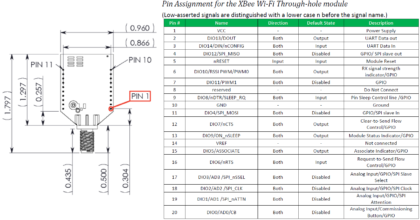LoRa物联网英文学习资料汇总
自制你的LoRa设备(英文:Building your LoRa devices)
IntroductioThis page describes how to build LoRa end-devices. We mostly focus on Arduino platforms ( and describe how to connect and use various LoRa radio module: Libelium LoRa, HopeRF RFM92W/RFM95W...了解详情DIY自制低成本LoRa网关(英文:A DIY low-cost LoRa gateway)
1. IntroductioThis page describes our low-cosLoRagateway based on a Raspberry PI. The gateway can receive from any LoRa device and is designed to be fully customizable for a targeted application with post-processing features based on high-level languages such as python. Typical post-processing features are to push the received data on various IoT/cloud platforms. Currently, we provide example for DropBoxTM, FirebaseTM, ThingSpeakTM, SensorCloudTM, GroveStreamsTM, FIWARE.The work presented here is part of the EU H2020 WAZIUP project (grant agreement number 687607, 2016-2019) which objective is to develop low-cost IoT solutions for deployment in sub-saharian African countries. Various applications are considered: water quality monitoring, cattle rustling, logistics and goods transportation. More details will come soon, but right now you can get the presentation of the developped gateway in.pdf.There are many advanced and well-integrated LoRa gateways capable of simultaneous reception on several channels and implementing the LoRaWAN specification (see slides). These gateways are based on the SX1301 baseband concentrator. Our LoRa gateway could be qualified as “single connection” as it uses the SX1272, much like an end-device would do. However, in order to increase LoRa transmission robutsness we improve the LoRa transmission with CSMA features (or so-called Listen Before Talk) and add Quality of Service guarantees with regards to radio time limitations. This solution keeps the cost of the gateway low and can satisfy small to medium size deployment scenario for ad-hoc application cases in various private usages, farming, agriculture, infrastructure surveillance, application-specific telemetry systems,… Note that more than 1 gateway can be deployed to serve several channel settings. However, it is probably not adapted, in the current state of development, to large-scale deployment with a large number of end customers from various different organizations with their own and different requirements regarding data management, confidentiality and security.Download:github(drop me a mail if you use our development so that we could advertise it)gw_full_latest folder: the latest version of the gateway softwarethe modified SX1272 library (initial version comes from Libelium) with enhanced features: support of SX1276, LBT & CSMA-like, …the arduPi library for RPI1 and RPI2the lora_gateway.cpp code (which compile on both RPI and Arduino)the makefilethe post-processing python scripts: cloud management, encryption, etc.Arduino folderthe modified SX1272 library (initial version comes from Libelium) with enhanced features: support of SX1276, LBT & CSMA-like, …the lora_gateway.ino code (which compile on both RPI and Arduino)an interactive end-device sketchvarious templates for most of Arduino boards (Uno, Mega, Due, Pro Mini, Teensy, etc.). Work out-of-the box with the gateway.a README.md for some installation/compilation instructionsourFAQ, explaining our LoRa framework, and especially why we are not LoRaWAN compatibleDownload:full SD card zipped imagefor the Raspberry gateway (based on Raspbian Jessie)Supports Raspberry 1B+, RPI2 and RPI3.Get the zipped image, unzip it, install it on an 8GB SD card, seethis tutorial from www.raspberrypi.orgPlug the SD card into your RaspberryConnect a radio module (see below)Power-on the RaspberryThe LoRa gateway starts automatically when RPI is powered onWith an RPI3, the Raspberry will automatically act as a WiFi access point. For RPI 1&2, see instructions on githubUpdate to the latest gateway version:https://github.com/CongducPham/LowCostLoRaGw#latest-gateway-versionBy default, incoming data are uploaded to ourLoRa ThingSpeak test channelWorks out-of-the-box with theArduino_LoRa_Simple_temp sketch2. Hardware componentsThe gateway is based on a Raspberry PI. RPI 1B+/2B/3B can be used. The LoRa modules comes from (a) Libelium LoRa radio module, (b) HopeRF RFM92W/HopeRF RFM95W (or RFM96W for 433MHz), (c) Modtronix inAir9/inAir9B (or inAir4 for 433MHz), (d) NiceRF LoRa1276. Libelium LoRa and RFM92W use the Semtech SX1272 chip while RFM95W, inAir9/9B and NiceRF LoRa1276 use the SX1276 which is actually more versatile.Figure: supported (tested) radio modulesFigure: Left: Hardware components with a Modtronix inAir9 radio module. Right: RPI GPIO header for RPI 1B (short) and RPI 2B/3B (long)Figure:GPIO header of the RPIUsing Libelium LoraFor the Libelium LoRa module, we directly connected the LoRa module without the connection bridge developed by Libelium to save the extra cost of the connection bridge, by just connecting the required SPI pins (MISO, MOSI, SPI_CLK and SPI_nSSEL), VCC and GND to the corresponding pins on the RPI (CE0 on the RPI for SPI_nSSEL and 3v3 for VCC). Pin out diagrams for the LoRa module in XBee format is shown below. The LoRa module from Libelium is however quite expensive: around 45€.Figure: XBee pin-out diagram for the Libelium LoRa moduleWe solder the wires to the pin as shown in the figure below. If the RPI is put in a case for outdoor usage, the radio module could just be fixed with the antenna or an SMA extension cable could be used. At the Raspberry side, you can simply plug the right cable end to the corresponding GPIO pin.Figure: using two 10-pin 2mm female socket to connect the LoRa module that has an XBee format. Right: the module is seen from the back sideFigure: connect the LoRa radio module to the RPI GPIO headerUsing HopeRF RFM92W/RFM95WNow, the HopeRF RFM92W (RFM95W) module is shown below. An adapter is need to have the break-out pins (the RFM92W module is quite small) and most importantly the antenna plug (which is in Female SMA). Note that the latest news from HopeRF indicated that the RFM92W is discontinued because the RFM95W is better. So you probably will have an RFM95W if you buy them now.Figure: the RFM92W module (left), the RFM92W adapter (middle), the RFM92W and the adapter before soldering, comparison with the Libelium LoRa for size (right)After some delicate soldering, we have the RFM92W module ready to be plugged on our Raspberry like previously: just connect the right cable to the GPIO header or use an additional header for fast insertion/removal of the radio module.Figure: the RFM92W and the adapter, after soldering (left), ready to be plugged on the Raspberry (middle), the adapter pin-out (right)The RFM92W (or RFM95W) with the adapter costs less than half of the Libelium LoRa (around 15€) which makes it quite attractive for our low-cost LoRa gateway. As both use the native SPI communication with the SX1272, the Libelium library can also drive the RFM92W, as explained in next section. See our low-cost gateway based on the RFM92W/95W at the end of the page.Using Modtronix inAir9We also tested with the Modtronix inAir9 which is based on the SX1276. This module has 2 advantages: it costs less than half of the Libelium LoRa (around 15€) and can come with the header pins already soldered! The left figure shows the radio module and the right figure shows the pin out.To connect the inAir to the Raspberry, proceed as previously: just connect the right cable to the GPIO header or use an additional header for fast insertion/removal of the radio module. Our first tests show that the inAir is reliable. Given its low cost and readiness (the RFM92W/RFM95W need some soldering) it is definitely a good choice. Note that there is an inAir9B with +20dBm transmit power but regulation is quite strict on such transmit power usage.Using the LoRa GPS HatTheLoRa GPS Hat from Draginois also a nice solution based on an RFM95W. Look at theDragino wikithat explain how to use their shield with our library (see example 4).Important notice for the SX1272 libraryNote that the original Libelium library to drive the LoRa module does not use DIO pins as many other libraries do, so there is no need to connect these pins. You can use other development codes using DIO pins by connecting the required pins that are mostly configured as follows DIO0 (RXdone or TX done), DIO1 (RX timeout) and DIO5 (ready). Of company, you have to check first. Some may also use the RST pin to reset the module.3. Main architectureInitially, the gateway was implemented on an Arduino (MEGA/Due) for test purpose and for having a “direct” transparent radio bridge. We enhanced the gateway code but maintained compatibility with Arduino therefore the main features are available on both platforms. On the RPI, we use the arduPI layer provided by Libelium to run both the SX1272 library and the gateway program. The original SX1272 library has been significantly improved to support also the SX1276, to add CSMA-like capability to increase LoRa efficiency and implement the possibility to dynamically ask for an ACK from the receiver side. This library basically drives the SX1272 through the SPI interface (it then works with no modifications with the HopeRF RFM92W and has some modifications for the SX1276). The most important point to mention is that the original library adds 5 bytes for internal usage as shown is the following figure, taken from the Libelium documentation.| dst addr (1 byte | src addr (1 byte | sequence number (1 byte | payload length (1 bytes | payload data (variable length | retry counter (1 byte |




